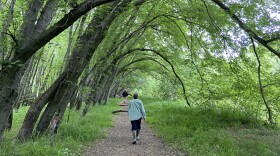Dave Anderson loves it when people are paying attention to trees. Fall is his favorite season, and he always finds foliage worthy of appreciation. But this year, he’s making a bold prediction.
“I'm willing to go out on a limb here and say that this year's fall foliage display could be the best that we've seen in the past decade,” says Dave Anderson, Senior Director of Education at the Forest Society and co-host of Something Wild on NHPR.
But why is Anderson willing to predict an especially colorful fall season this year?
“We had a ‘Goldilocks’ summer. Not too wet, not too dry, not too many insect outbreaks, and there's a lot of green leaves remaining on the trees at Labor Day weekend,” he says. “And all those leaves are going to change slowly over the next couple of weeks.”
Get more New Hampshire news in your inbox: Sign up for the free Rundown newsletter.
Peak foliage, he says, is more of a procession than a moment. People tend to think of it like the eclipse, with a moment of totality, he said — but “foliage doesn't work like an eclipse.”
Chris Martin, Anderson’s Something Wild co-host, is also a bit of a foliage connoisseur, particularly in his work traveling the state on behalf of NH Audubon. He thinks of foliage in terms of “peaks,” not just one “peak.”
“I think that there are peaks. It's not just one peak. I mean, there's this brilliant red, which I think is from red maple trees or swamp maples. Six weeks later, there's this bronze that comes over the hills from oaks or hickory. That's already two peaks, six weeks apart.”
“I mean, there's this brilliant red, which I think is from red maple trees or swamp maples,” Martin says. “Six weeks later, there's this bronze that comes over the hills from oaks or hickory. That's already two peaks, six weeks apart.”
Foliage in New Hampshire varies with latitude and elevation. But there are other factors as well, including what type of forest you're in. The soil also varies significantly across the state, Anderson says.
“Are you in the dry outwash plain of the Seacoast, or are you in a rich mesic forest of the Upper Valley, with a lot of maple?” he says. “Bronzes are oak forests in southern areas and the coastal plain.”
The bright reds that start early in September tend to concentrate around wetlands, Anderson explains.
There’s also a lot of variation in how the foliage colors are produced.
“Orange and yellow have been there all along, you just didn’t see it,” says Anderson. “It was masked beneath the green chlorophyll in the leaves all summer.”
The yellow and orange hues on the leaves are revealed after the chlorophyll starts breaking down in the fall, he explained.
But that’s not how it works for red leaves, most often recognized on what Anderson calls the “rock stars of the foliage world” — sugar maples and red maples. The ruby hues show up from sugars trapped in their leaves, he says.
“As the trees begin to prepare for losing their leaves, they form a corky layer at the base of the leaf stem, which is called a petiole,” Anderson explains. “The corky layer traps some sugars in the leaf so they can't store it in the roots.”
The maple trees convert those sugars to starch, which is more stable than sugar, and later reconvert it to sugar in the spring and send it up through the trees. This is where the weather plays a role, according to Anderson.
“In the presence of sunlight in the fall, the trees convert that trapped sugar into brighter colored pigments,” Anderson says.
“This is where the weather plays a role, according to Anderson. “In the presence of sunlight in the fall, the trees convert that trapped sugar into brighter colored pigments.”
The only potential spoiler? A hurricane could strip the leaves off the trees, or prolonged rain could dim colors due to a lack of sunshine.
“When I envision peak foliage,” says Martin, “happens in the mountains where you've got balsam fir and white spruce, that stay evergreen, mixed right in with those brilliant maple trees, and maybe the yellow birch, too, creating a contrast between the dark green and the colors.”
“Add in a little frosting of snow in the upper peaks of the Presidential range,” Anderson chimes in, “and you've got the quintessential fall White Mountain postcard.”
Something Wild is a joint production of the Society for the Protection of New Hampshire Forests, NH Audubon and NHPR.











